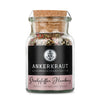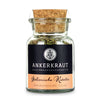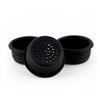The caramel coconut blossom sugar
Nobody can always say no to a sweet temptation - sometimes you just have to take the plunge! Especially when it's such a sugary variety. Our coarse coconut blossom sugar in the 100 gram jar or the 250 gram refill bag is not only noticeable because of its brownish color.
It is a specific type of so-called palm sugar, which is obtained by boiling down the flower juices of different types of palm - in this case, the coconut palm is used for production, resulting in coconut sugar. For other varieties, the sugar palm or the nipa palm, for example, are used, all of which are mainly grown in Southeast Asia. They like a tropical and warm, humid climate to grow. Depending on the country of origin and the cultivation of the plants, the taste and appearance of the sweetener may vary slightly.
To produce coconut blossom sugar, the plant sap, the so-called nectar, is first extracted from the flowers. In order not to ferment, it must then be further processed as quickly as possible: If the nectar is not being fermented into palm wine or palm vinegar, it can be boiled down into a thick coconut blossom syrup. When this syrup is then allowed to crystallize with the help of heat and constant stirring, it can then be cooled, crushed and become the condiment that many love.
Special production, special ingredients
The palm sap obtained during harvest is carefully sieved so that it no longer contains any solid plant parts or other foreign substances. And we no longer add any additives or flavor enhancers. So you are buying a product with the best ingredients and high quality, which is manufactured by hand and without mechanical help. After climbing into the palm tree crown, the individual flowers are finely scratched lengthwise with knives directly on the palm tree or picked from the ground in order to extract the high-quality nectar from them. This later becomes syrup and then the finished sugar product. The palm trees are usually not felled for harvesting, so that production takes place sustainably and the flowers can grow back.
What is particularly valuable is the fact that the coconut blossom sugar is not refined and therefore retains the full range of its ingredients. Refining involves decolorizing the sugar through, among other things, filtration and centrifugation so that it appears pure and white. However, when unrefined it is brown-reddish and coarse. For use at Cooking or Baking You can either use it directly or grate it even finer in a mortar beforehand. The special sugar is also often used in vegan cuisine, such as in vegan chocolate muffins or cakes.
The difference to “normal” sugar
Coconut blossom sugar is an exotic alternative to “normal” sugar and can be used almost 1:1 as a different variant for seasoning. But the level of sweetness is not the same, as palm sugar tastes slightly less sweet than refined, white table sugar. It even has a slightly malty note that is reminiscent of caramel, setting it apart from other sweeteners. Of course you can also cook and bake with this coconut variant. Thanks to its fairly good water solubility, it can also be used wonderfully to refine drinks, whether warm or cold.
The caramel note makes the use of coconut blossom sugar in the taste so special and exciting. This aroma can be particularly welcome in coffee or baked desserts. Same in ours Ankerkraut Strawberry tiramisu Refined with whipped cream, fresh strawberries and Bailey's. By the way: Surprisingly, this seasoning does not taste like the hard fruit of the coconut palm with the white flesh, as the name suggests, but only sweet and slightly malty like caramel. Instead of palm trees, household sugar is obtained from sugar beets or cane and therefore not only has a different taste, but also a completely different origin, as we have now learned.

















